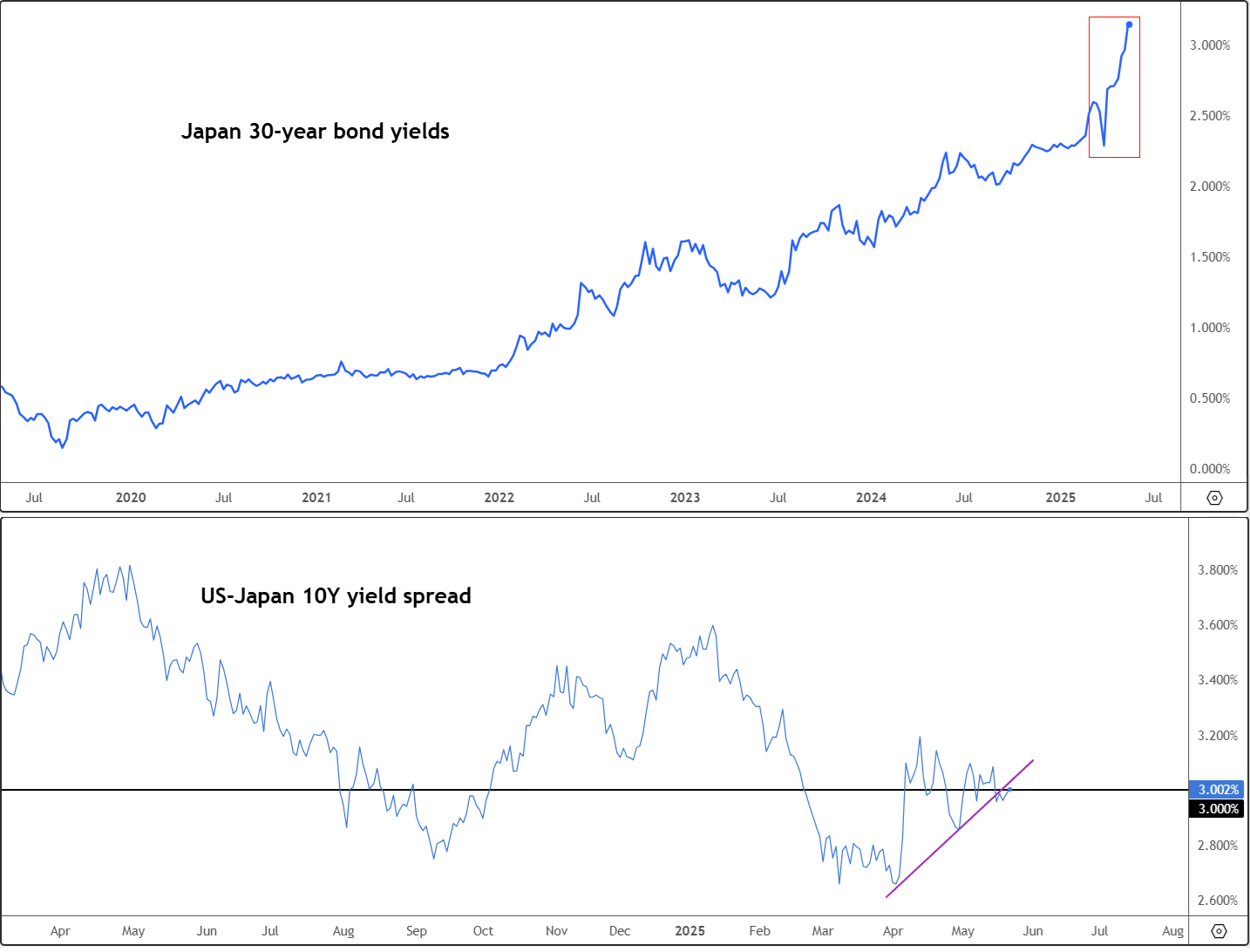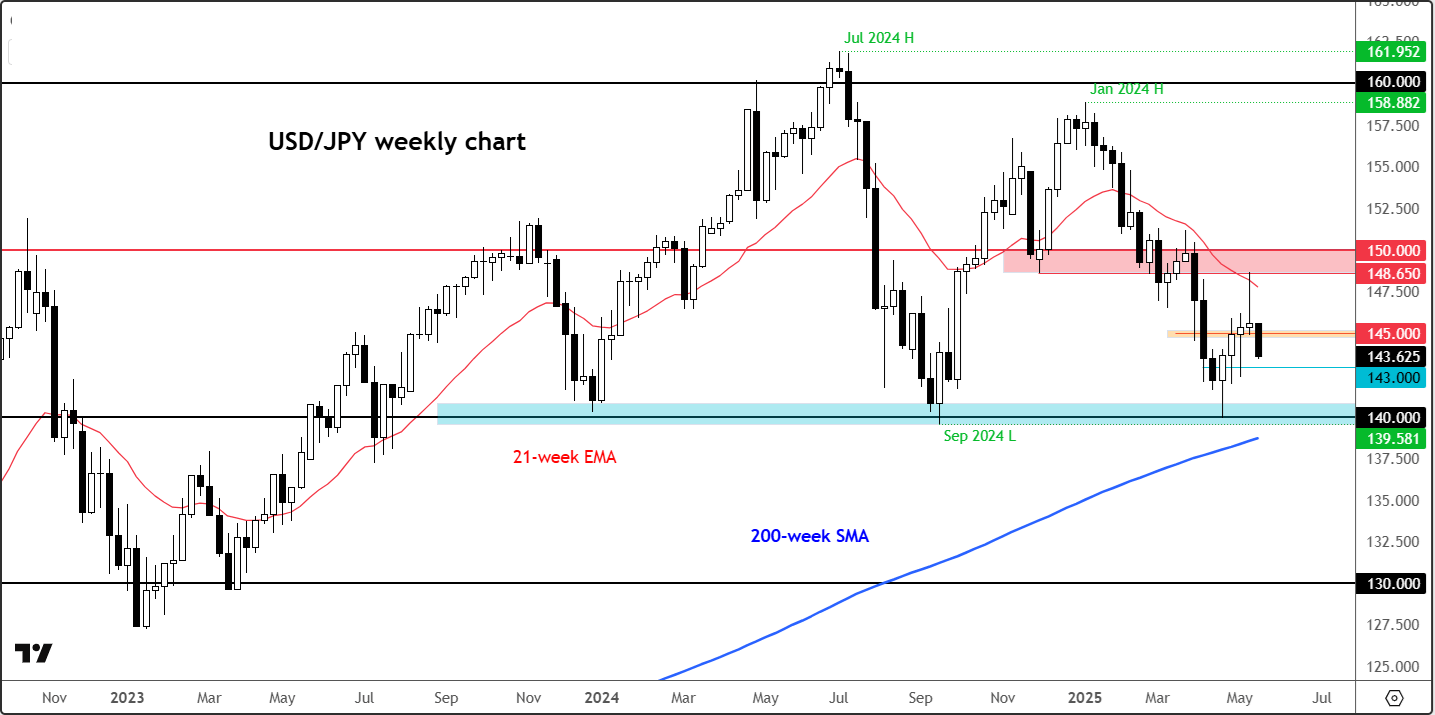European stocks retreat on tech valuation concerns; U.K. economic woes
- A yield shock in Japan is shaking up global FX markets—and the dollar is feeling it.
- As USD/JPY slides and DXY breaks down, the yen is regaining its haven crown.
- With US credit concerns rising and G7 talks looming, the dollar’s path just got trickier.
The US dollar remains under pressure as we move into the latter half of the week. While macroeconomic data has been light, FX volatility has picked up, particularly around USD/JPY and therefore the dollar index (DXY). As global bond markets wobble — led by a sharp move in Japan — traditional safe havens like the yen and gold are reasserting their place. Meanwhile, growing concerns over America’s fiscal outlook are adding further bearish momentum to the dollar index.
Japan’s Yield Shock Could Break the Carry Trade
Let’s address the headline event: Japan’s 30-year government bond yield hit a record high of 3.197% today. That figure may seem modest by Western standards, but it’s seismic for a nation long associated with rock-bottom rates. With inflation gaining traction and the Bank of Japan creeping toward normalization, the once-popular yen carry trade — borrowing at near-zero in Japan and investing elsewhere — may be starting to unravel, just like it did last summer.
Why does this matter for USD/JPY and the US Dollar Index direction? Because higher Japanese yields shrink the yield gap with US Treasuries, weakening the incentive to hold dollars. Last week’s price action saw USD/JPY stall beneath resistance at 148.65–150.00, forming an inverted hammer pattern on the weekly chart — a signal of a potential bearish reversal. If yields continue rising in Japan, the yen could strengthen even more sharply.
With the spread between US and Japanese bond yields narrowing, the trend now favours the yen. USD/JPY, which had recently bounced near 140.00, is under pressure again. If the pair fails to reclaim 145.00 convincingly, bears may target the 140.00 zone — or lower.
Macro (BCBA:BMAm) Watch: G7 Talks and Rising US Credit Risk
While today’s economic calendar is light, attention will turn to the G7 meeting in Canada, where US and Japanese officials are likely to address FX policy. Japan has mostly remained silent on the yen’s weakness — until now. Prime Minister Ishiba’s recent comments comparing Japan’s debt position to that of Greece suggest a growing urgency.
Across the Pacific, the US is also feeling fiscal strain. Credit default swap (CDS) spreads have risen to 55.1 basis points in May — just shy of levels last seen during the 2011 debt ceiling scare. While these spreads remain below those of riskier sovereigns, they highlight increasing concern about the US’s ballooning debt and sticky inflation.
Consider this: Japan holds roughly $1.1 trillion in US Treasuries. If Tokyo is forced to sell in defence of its currency or markets, US yields could surge just as America’s credit profile deteriorates. The world’s two largest debt markets are walking a tightrope, putting the USD/JPY forecast into sharp focus.
Dollar Index Technical Breakdown Signals Further Weakness
From a technical standpoint, the dollar index is turning increasingly bearish. DXY has broken down from a bear flag pattern and slipped below key support at 100. It’s now trading under the July 2023 low of 99.57. The next target lies at 99.00, followed by 97.92 — the April 2025 low. The path of least resistance remains to the downside unless the DXY can reclaim the broken support trend from the bear flag structure. A successful reclaim could open the door for a meaningful rebound, but so far, that remains unlikely.
USD/JPY Risks Deeper Correction Toward 140.00
USD/JPY broke below the 145.00 level this week — a critical psychological and technical zone. This was also last week’s low, reinforcing its importance. The inverted hammer pattern seen between 148.65 and 150.00 — previously a key support zone — turned into a strong resistance band, hinting at continued downside.
The next support is around 143.00, followed by the big test at 140.00. A move below that could bring the September 2024 low of 139.58 into play. Such a scenario likely requires further pressure from Japanese bond markets.
On shorter timeframes, some support may emerge around 143.24 (61.8% Fib) and 141.76 (78.6%), but unless 145.00 is reclaimed with strength, the broader trend still favours a weaker dollar.
***
Subscribe now and instantly unlock access to several market-beating features, including:
- ProPicks AI: AI-selected stock winners with a proven track record.
- InvestingPro Fair Value: Instantly find out if a stock is underpriced or overvalued.
- Advanced Stock Screener: Search for the best stocks based on hundreds of selected filters and criteria.
- Top Ideas: See what stocks billionaire investors such as Warren Buffett, Michael Burry, and George Soros are buying.

Disclaimer: This article is written for informational purposes only; it does not constitute a solicitation, offer, advice, counsel or recommendation to invest as such it is not intended to incentivize the purchase of assets in any way. I would like to remind you that any type of asset, is evaluated from multiple perspectives and is highly risky and therefore, any investment decision and the associated risk remains with the investor.
